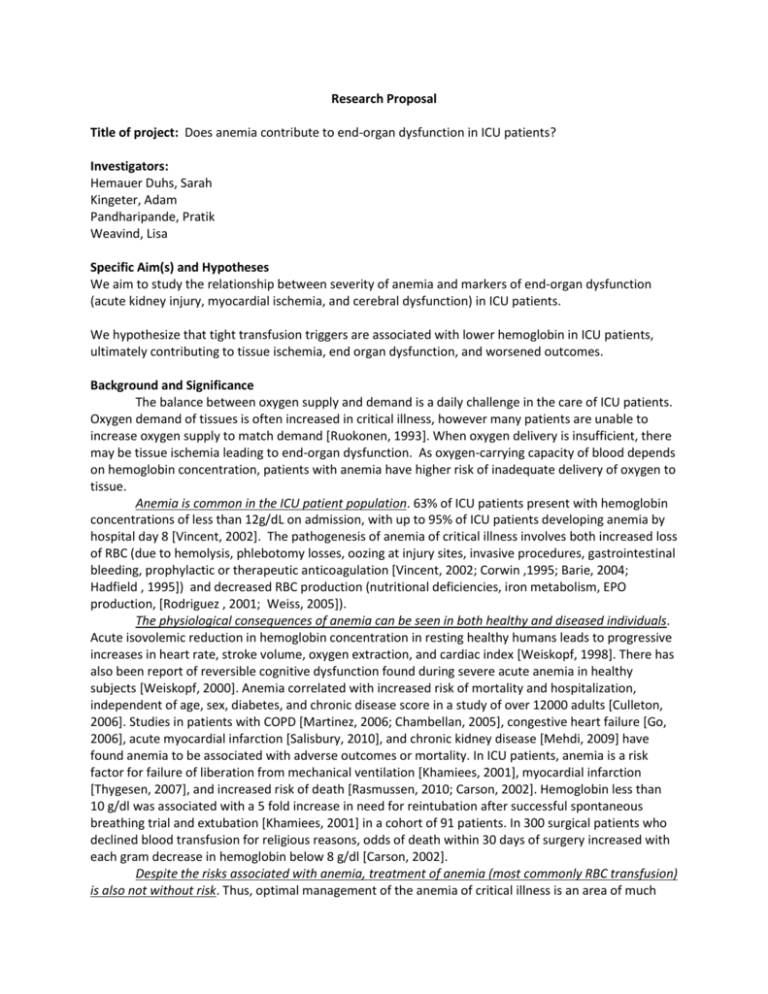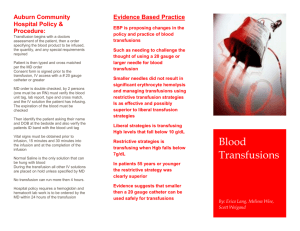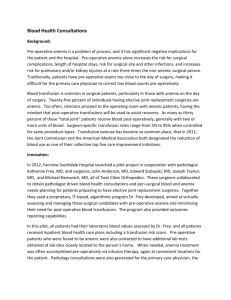Research Proposal
advertisement

Research Proposal Title of project: Does anemia contribute to end-organ dysfunction in ICU patients? Investigators: Hemauer Duhs, Sarah Kingeter, Adam Pandharipande, Pratik Weavind, Lisa Specific Aim(s) and Hypotheses We aim to study the relationship between severity of anemia and markers of end-organ dysfunction (acute kidney injury, myocardial ischemia, and cerebral dysfunction) in ICU patients. We hypothesize that tight transfusion triggers are associated with lower hemoglobin in ICU patients, ultimately contributing to tissue ischemia, end organ dysfunction, and worsened outcomes. Background and Significance The balance between oxygen supply and demand is a daily challenge in the care of ICU patients. Oxygen demand of tissues is often increased in critical illness, however many patients are unable to increase oxygen supply to match demand [Ruokonen, 1993]. When oxygen delivery is insufficient, there may be tissue ischemia leading to end-organ dysfunction. As oxygen-carrying capacity of blood depends on hemoglobin concentration, patients with anemia have higher risk of inadequate delivery of oxygen to tissue. Anemia is common in the ICU patient population. 63% of ICU patients present with hemoglobin concentrations of less than 12g/dL on admission, with up to 95% of ICU patients developing anemia by hospital day 8 [Vincent, 2002]. The pathogenesis of anemia of critical illness involves both increased loss of RBC (due to hemolysis, phlebotomy losses, oozing at injury sites, invasive procedures, gastrointestinal bleeding, prophylactic or therapeutic anticoagulation [Vincent, 2002; Corwin ,1995; Barie, 2004; Hadfield , 1995]) and decreased RBC production (nutritional deficiencies, iron metabolism, EPO production, [Rodriguez , 2001; Weiss, 2005]). The physiological consequences of anemia can be seen in both healthy and diseased individuals. Acute isovolemic reduction in hemoglobin concentration in resting healthy humans leads to progressive increases in heart rate, stroke volume, oxygen extraction, and cardiac index [Weiskopf, 1998]. There has also been report of reversible cognitive dysfunction found during severe acute anemia in healthy subjects [Weiskopf, 2000]. Anemia correlated with increased risk of mortality and hospitalization, independent of age, sex, diabetes, and chronic disease score in a study of over 12000 adults [Culleton, 2006]. Studies in patients with COPD [Martinez, 2006; Chambellan, 2005], congestive heart failure [Go, 2006], acute myocardial infarction [Salisbury, 2010], and chronic kidney disease [Mehdi, 2009] have found anemia to be associated with adverse outcomes or mortality. In ICU patients, anemia is a risk factor for failure of liberation from mechanical ventilation [Khamiees, 2001], myocardial infarction [Thygesen, 2007], and increased risk of death [Rasmussen, 2010; Carson, 2002]. Hemoglobin less than 10 g/dl was associated with a 5 fold increase in need for reintubation after successful spontaneous breathing trial and extubation [Khamiees, 2001] in a cohort of 91 patients. In 300 surgical patients who declined blood transfusion for religious reasons, odds of death within 30 days of surgery increased with each gram decrease in hemoglobin below 8 g/dl [Carson, 2002]. Despite the risks associated with anemia, treatment of anemia (most commonly RBC transfusion) is also not without risk. Thus, optimal management of the anemia of critical illness is an area of much controversy and ongoing research. The CRIT study found that 44% of patients received one or more RBC units while in the ICU [Corwin, 2004]. However, the use of RBC transfusion is expensive (in 2008, the mean payment for one unit of leukocyte-reduced red blood cells in the United States was $ 223 per the 2009 national blood collection and utilization survey report), resource intensive and of unclear clinical benefit. Apart from complications such as allergic reactions, volume overload etc., the CRIT study also found that the number of RBC units transfused was an independent predictor of worse clinical outcomes. Other studies have shown that blood transfusions are associated with immunosuppressive complications, especially in the critically ill. Restricted transfusion thresholds and outcomes. In a randomized controlled trial of critically ill patients [Hebert, 1999] a strategy of transfusing only when Hb dropped below 7g/dl compared to if it dropped below 10 g/dl showed a reduction in transfusions in the restrictive group with no worse outcomes. Subgroup analysis of younger patients and those less severely ill showed worse outcomes in the liberally transfused group. Furthermore, a 2012 Cochrane review analyzed 19 studies of 6264 patients to examine the relationship between red cell transfusion thresholds and change in clinical outcomes [Carson, 2012]. Patients assigned to a restrictive transfusion strategy (Hgb 7-9 g/dL) had received on average 1.19 fewer units of RBC and had hemoglobin concentration on average 1.5% lower than patients assigned to a liberal transfusion strategy. Hospital mortality was 23% lower in patients assigned to a restrictive transfusion strategy as compared to those assigned to a liberal transfusion strategy. Restricted transfusion practices are now incorporated into routine care. Many hospitals have created institutional guidelines in an attempt to reduce blood product use, with a subsequent reduction in mean Hgb concentrations. For example, Vanderbilt has developed strict transfusion guidelines implemented at the point of order entry. All orders entered at Vanderbilt must be placed through a computerized order system (Wiz). Specific order sets have been designed for the ordering of RBC’s, FFP and Cryoprecipitate, and platelets. To order red blood cells, the ordering physician must list reason for transfusion, number of units to be reserved and/or transfused, whether or not irradiated blood is required, and method of delivery of blood products. Utilizing this existing digital framework, Wiz order sets for the transfusion of RBC’s were modified. Transfusions for the reason of symptomatic anemia were limited to 1u pRBC, and all transfusions required listing of attending physician approving the transfusion. Although the CRIT study found transfusion to be independently associated with increased mortality, nadir Hb was also independently associated with worsened outcome [Corwin, 2004]. We hypothesize that restrictive transfusion strategies result in lower daily Hb and an increase in ischemic related complications, end organ dysfunction, morbidity, and health care associated costs, even when the risks of transfusion are accounted for. Research Design and Methods Methods: The proposed study will be a post-hoc analysis of prospectively collected data from the BRAIN-ICU observational cohort study of medical and surgical ICU patients admitted with respiratory failure or shock Study Population: Vanderbilt BRAIN-ICU cohort ANALYSIS 1: Daily lowest Hb and predicted outcome the next day (while in ICU) Independent Variable -Daily lowest hemoglobin Dependent Variables (next day): - Daily delirium (positive CAM-ICU) - Daily troponin (>0.1) as an index of cardiac dysfunction AND as a continuous variable - Daily renal SOFA score (≥2) as an index of acute kidney injury AND as a continuous variable (creatinine) - Daily resp SOFA score (≥2) as an index of acute respiratory dysfunction - On ventilator Y/N (as a measure of success of extubation) Confounders: Baseline - Age - Weight - Medical vs. surgical ICU status - APACHE score - Charleston comorbidity index - Framingham stroke risk profile Daily risk factors - Lowest daily mean arterial pressure - ICU day - ICU day * lowest daily Hb - daily severe sepsis yes/no - transfusion (nos of units) Statistical Analysis: Linear (troponin, creatinine) and logistic (delirium, SOFA, ventilator) mixed effects regression will be used to assess the effect of daily lowest hemoglobin level on each dependent variable, adjusting for the fixed effects of confounders listed above. Random effects will be used to account for the correlation among repeated measurements on individual patients. The adjusted effect (linear or odds ratio) of lowest daily Hb will be summarized using 95% confidence intervals. ANALYSIS 2: Hb during ICU stay and predicted outcomes Independent Variable -Lowest hemoglobin during ICU (prior to outcome) -mean Hb during ICU stay (running average prior to outcome) Dependent Variables: A. ICU mortality B. Time to event analysis 1. Death 2. Cardiac dysfunction (Troponin I > 0.1) 3. Renal dysfunction (renal SOFA >2), 4. Time to dialysis 5. Time to resolution of delirium (CAM negative for 48 hours) 6. Time to successful extubation (off ventilator for 48 hours) Confounders: Baseline - Age - Weight - Medical vs. surgical ICU status - APACHE score - Charleston comorbidity index - Framingham stroke risk profile Time varying - mean SOFA score (running average prior to outcome) - duration of severe sepsis (prior to outcome) - number of units transfused (running average prior to outcome) Statistical Analysis: Logistic regression and or Cox proportional hazards regression with time-varying covariates will be used to assess the effects of lowest and mean hemoglobin on the dependent variables listed above, adjusting for each confounder. The adjusted effects (odds or hazard ratios) will be summarized using 95% confidence intervals. Sample size: Brain ICU cohort (821 patients) Literature cited Barie PS. Phlebotomy in the intensive care unit: strategies for blood conservation. Crit Care 2004;8:S34– S36. Carson JL, Carless PA, Hebert PC. Transfusion thresholds and other strategies for guiding allogeneic red blood cell transfusion. Cochrane Database Syst Rev 2012;4:CD002042. Carson JL, Noveck H, Berlin JA, Gould SA. Mortality and morbidity in patients with very low postoperative Hb levels who decline blood transfusion. Transfusion 2002;42:812–818. Chambellan A, Chailleux T, Similowski T. Prognostic value of the hematocrit in patients with severe COPD receiving long term oxygen therapy. Chest 2005;128:1201–1208. Corwin HL, Gettinger A, Pearl RG, et al. The CRIT Study: Anemia and blood transfusion in the critically ill-current clinical practice in the United States. Crit Care Med 2004;32:39-52. Corwin HL, Parsonnet KC, Gettinger A. RBC transfusion in the ICU: is there a reason?Chest 1995;108:767–771. Culleton BF, Manns BJ, Zhang J, Tonelli M, Klarenbach S, Hemmelgarn BR. Impact of anemia on hospitalization and mortality in older adults. Blood 2006;107:3841–3846. Go AS, Yang J, Ackerson LM, Lepper K, Robbins S, Massie BM, Shlipak MG. Hemoglobin level, chronic kidney disease, and the risks of death and hospitalization in adults with chronic heart failure: the Anemia in Chronic Heart Failure: Outcomes and Resource Utilization (ANCHOR) Study. Circulation 2006;113:2713–2723. Hadfield RJ, Sinclair DG, Houldsworth PE, Evans TW. Effects of enteral and parenteral nutrition on gut mucosal permeability in the critically ill. Am J Respir Crit Care Med 1995;152:1545–1548. Hebert PC, Wells G, Blajchman MA, Marshall J et al. A Multicenter, Randomized, Controlled Clinical Trial of Transfusion Requirements in Critical Care. N Engl J Med 1999; 340:409-417 Khamiees M, Raju P, DeGirolamo A, Amoateng-Adjepong Y, Manthous CA. Predictors of extubation outcome in patients who have successfully completed a spontaneous breathing trial. Chest 2001;120:1262–1270. Martinez FJ, Foster G, Curtis JL, Criner G, Weinmann G, Fishman A, DeCamp MM, Benditt J, Sciurba F, Make B, et al. NETT Research Group. Predictors of mortality in patients with emphysema and severe airflow obstruction. Am J Respir Crit Care Med 2006;173:1326–1334. Mehdi U, Toto R. Anemia, diabetes, and chronic kidney disease. Diabetes Care 2009;32:1320–1326. Rasmussen L, Christensen S, Lenler-Petersen P, Johnsen SP. Anemia and 90-day mortality in COPD patients requiring invasive mechanical ventilation. Clin Epidemiol. 2010;3:1–5. Rodriguez RM, Corwin HL, Gettinger A, Corwin MJ, Gubler D, Pearl RG. Nutritional deficiencies and blunted erythropoietin response as causes of the anemia of critical illness. J Crit Care 2001;16:36–41. Ruokonen E, Takala J, Kari A, Saxén H, Mertsola J, Hansen EJ. Regional blood flow and oxygen transport in septic shock. Crit Care Med1993;21(9):1296-1303 Salisbury AC, Alexander KP, Reid KJ, Masoudi FA, Rathore SS, Wang TY, Bach RG, Marso SP, Spertus JA, Kosiborod M. Incidence, correlates, and outcomes of acute, hospital-acquired anemia in patients with acute myocardial infarction. Circ Cardiovasc Qual Outcomes 2010;3:337–346. Semenza GL. Regulation of oxygen homeostasis by hypoxia-inducible factor 1. Physiology (Bethesda) 2009;24:97–106. Thygesen K, Alpert JS, White HD. Joint ESC/ACCF/AHA/WHF Task Force for the Redefinition of Myocardial Infarction. Universal definition of myocardial infarction. Eur Heart J 2007;28:2525– 2538. Vincent JL, Baron JF, Reinhart K, Gattinoni L, Thijs L, Webb A, Meier-Hellmann A, Nollet G, Peres-Bota D. ABC (Anemia and Blood Transfusion in Critical Care) Investigators. Anemia and blood transfusion in critically ill patients. JAMA 2002;288:1499–1507. Weiskopf RB, Kramer JH, Viele M, Neumann M, Feiner JR, Watson JJ, Hopf HW, Toy P. Acute severe isovolemic anemia impairs cognitive function and memory in humans. Anesthesiology 2000;92:1646–1652. Weiskopf RB, Viele MK, Feiner J, Kelley S, Lieberman J, Noorani M, Leung JM, Fisher DM, Murray WR, Toy P, et al. Human cardiovascular and metabolic response to acute, severe isovolemic anemia. JAMA 1998;279:217–221. Weiss G, Goodnough LT. Anemia of chronic disease. N Engl J Med 2005;352:1011–1023.






